Tulare County is the largest dairy producer in California and the US. But as climate change exposes the region’s vulnerability, could the industry collapse under its own weight?
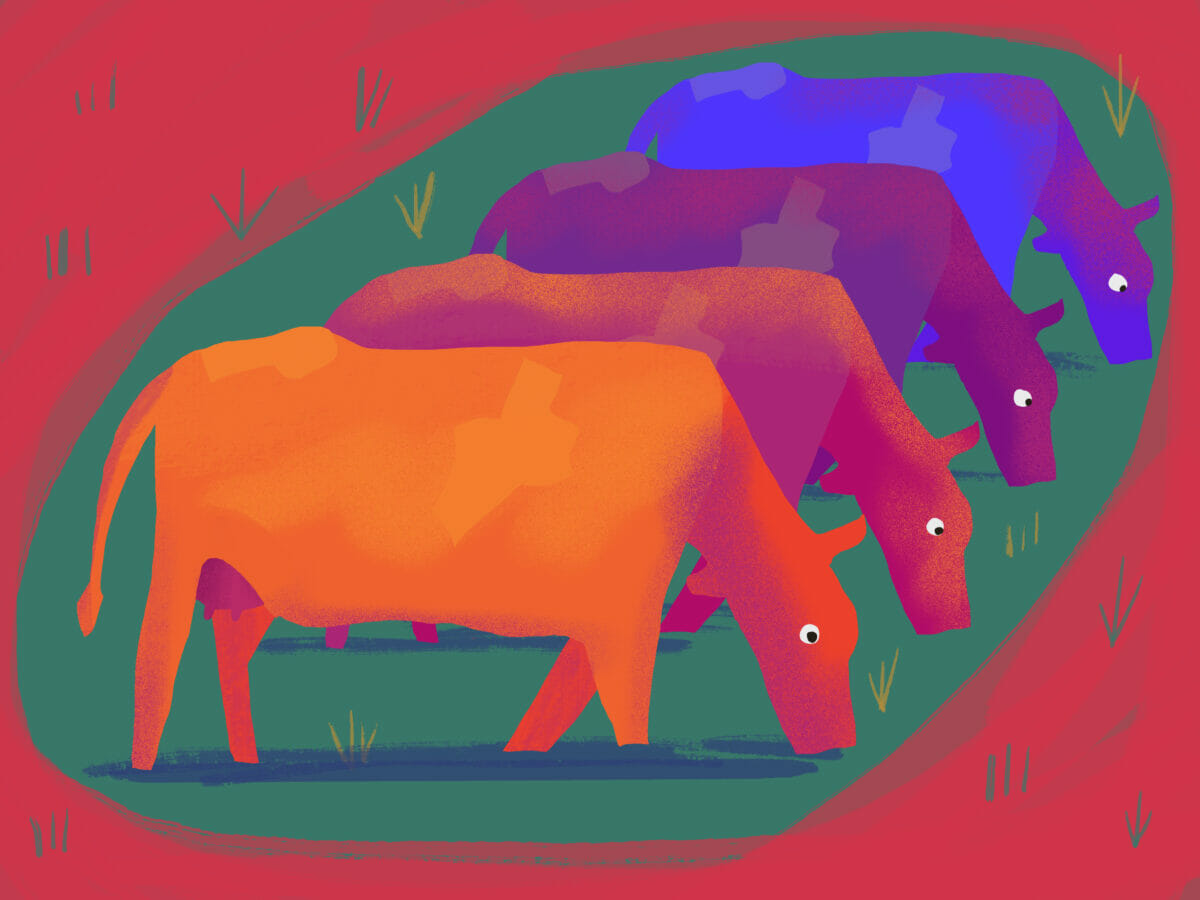
For Joseph Goni, a fourth-generation dairy farmer in Tulare County, California, the region’s historic floods were part of family lore. As such, his grandfather, who lived through the 1955 deluge, often stressed the proper maintenance of the berms protecting the ranch from the nearby Tule River—a lesson echoed by his father, who faced a similar event in 1983.
But the epic flooding this past March was simply unprecedented, says the owner of Lerda-Goni Farms. After a winter of record snow in the Sierra Nevada Mountains, a sudden warm spell melted the lower reaches, unleashing nearly 40,000 acre-feet of water—a volume equal to more than a tenth of Las Vegas’ annual supply—in 48 hours. The torrent overwhelmed dams, swelled rivers and crumbled levees, inundating entire farming communities, including Lerda-Goni and a dozen other ranches, and reawakening a long-dormant lake lying beneath the vast agricultural region.
With floodwater breaching six-foot high banks, “I don’t know what we could have done to prevent it,” says Goni. “It was just an insane amount of water in such a short amount of time.” Months later, he’s still shell-shocked from having to relocate his herd of 2,400 cows in the middle of the night—a Herculean effort pulled off by his team of 11 long-time employees, neighbors and countless volunteers, some who hailed from as far away as Nevada.
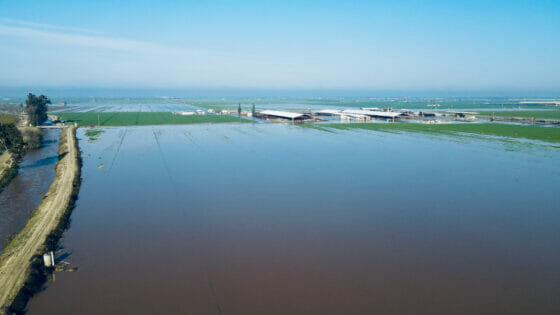
The reemergent Tulare Lake is not expected to drain for up to two years. (Photo courtesy of Lerda-Goni Farms)
All told, one official estimate pegs the dairy industry’s losses at $10 billion. While the lake has drained down to about 168 square miles, a chilly spring also kept the high-elevation snowpack at a slow melt, helping to avert an even greater calamity in the low-slung basin. Yet, as whole farming communities dig themselves out of the muddy ruins, the growing uncertainty of climate change is darkening a cloud over the future of the region’s largest industry—one valued at nearly $2 billion annually.
Following multiple years of drought, the diluvian whiplash is just the latest in a mounting list of burdens facing the basin’s largest industry, which pumps out 54 percent of California’s milk supply. As environmental adversity—along with the strain of rising costs and regulations—tightens the squeeze, many smaller, family-owned ranches have been caving to consolidation pressure. And that’s tipping the landscape in favor of mega-dairies—the large-scale operations that critics point to as disproportionate contributors of human-induced climate change.
At this point, “our farm is pretty self-sufficient,” says Goni, as he rushed to plant summer feed corn on his barely dry fields. His 580-acre farm grows enough forage to supply the herd, so “I’m good with where I’m at,” he adds. Still, the trend of getting big or getting out is all too real, adds the farmer, who’s seen plenty of small dairies pushed out in his lifetime. “But I’ll leave that [decision] for my nephews, for the next generation.”
Located in the southern reaches of the San Joaquin Valley, about 200 miles north of Los Angeles, Tulare Lake was once the largest body of freshwater west of the Mississippi River. Fed by four rivers flowing from the Sierra Nevadas, the shallow inland sea covered 1,000 square miles—more than four times the surface area of Lake Tahoe. Vast tule marshes surrounded its banks, creating a rich ecosystem teeming with fish and birds that, in turn, supported the Tachi Yokut and other Native American communities.
As westward expansion swept across the region in the late 1800s, settlers began draining the 40-foot deep lake for farmland. Within decades, a network of dams, levees and canals had dried up the basin, transforming the fertile crater into an agricultural hub. Today, the four counties sitting in the lake bed account for more than $25 billion in food and crop production, with Tulare County ranking number one in the nation for milk and oranges. Neighboring Fresno and Kern Counties top the list for almonds, while Kings County rules the state in cotton production.
But thirsty crops and cattle have taken their toll: Amid California’s cycles of drought, excessive groundwater pumping has left Central Valley basins the most overdrafted in the state. Although California’s Sustainable Groundwater Management Act (SGMA) aims to recharge them by regulating draws, the dried-up lake bed has long been collapsing under the massive weight of industrialized agriculture—to the tune of a couple of inches per month.
As climate change fuels more extreme swings in weather patterns, subsidence further compounds the region’s issues, says John Abatzoglou, professor of climatology at University of California, Merced, with arid years advancing the sink and wet ones expanding flood risk.
The tanking basin is also wreaking havoc on the region’s extensive canal system and levees. Corcoran, a community of 22,000 in Kings County with a sizable population of agricultural laborers and a large state prison, is scrambling to raise its 14-mile-long embankment, which has already collapsed by several feet since getting a $10-million boost just five years ago. As future deluges become more severe, maintaining, repairing and upgrading valley infrastructure will require greater investment, says Abatzoglou.
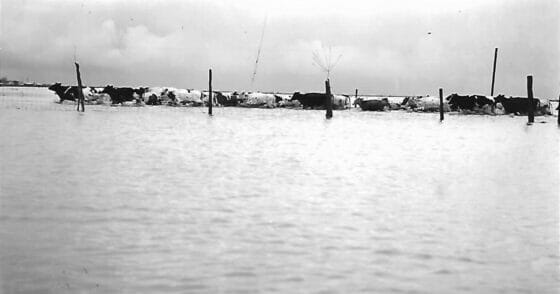
Dairy farmer Joseph Goni’s grandfather witnessed the 1955 deluge that flooded their farm. (Photo courtesy of Lerda-Goni Farms)
Since the 1983 flood, changes in farming patterns have also raised the basin’s economic risk, he notes. Orchards, vines and other perennials cultivated as long-term investments have steadily replaced ephemeral crops such as tomatoes and cotton, which are far less costly to sacrifice or replace. Meanwhile, the consolidation of dairies has led to a sharp increase in herd size despite a plummeting number of farms, reflecting a national trend.
“It’s a different playing field,” says Abatzoglou. Ultimately, the altered landscape means that climate-related disasters including floods, wildfires and drought will all take a deeper toll on agriculture—fruit and nut farmers having to abandon decade-old trees, for instance, or cattle ranchers needing to relocate hundreds of thousands of cows at a moment’s notice. And that’s on top of less snowpack and quicker melts thanks to a warming climate, as well as shrinking milk production from heat-stressed herds.
As individual farmers reel from the most recent disaster, many are up against the consequences of a new normal, says Anja Raudabaugh, chief executive officer of Western United Dairies, a Fresno-based industry trade organization. “Insurance carriers are not going to tolerate this again,” she adds, so farmers in floodplains are bracing themselves for a range of costly upgrades, including raising the elevation of entire feed lots and barns.
In an industry known for razor-thin margins and a grueling, 365-days-a-year schedule, Raudabaugh sees consolidation accelerating. Although herds of 1,200 used to be the norm not too long ago, small family dairies are increasingly merging into 4,000- to 6,000-head operations. Larger players have more buying power and efficiency to manage rising operational costs, she says, so “becoming bigger is like a risk buffer.”
And in recent years, the soaring cost of feed and water scarcity—both compounded by drought and SGMA regulations—have made consolidation pressure all the more acute in California. “Despite the resilience of family [farms], the mega-trend is undeniable,” says Raudabaugh.
With the growing scale comes a ballooning environmental footprint: More inputs of feed and water increase output, which includes greater methane emissions. Dairy and livestock account for more than half of California’s production of the powerful greenhouse gas (GHG), one that traps 84 times more heat than carbon dioxide.
In Tulare County, where nearly half a million milk cows live on 222 dairies, the sheer density of large operations also magnifies other impacts, says Andrew deCoriolis, executive director of Farm Forward, a Portland-based humane farming advocacy organization. Concentrated animal feeding operations (CAFOs) have been linked to numerous environmental issues such as nitrate contamination of groundwater and bacterial runoff, as well as dust storms and poor air quality (the county ranks among the worst in the nation).
“On a local and regional [level], it would be hard to point to another industry—except maybe oil and gas refining—with as much emissions and pollution,” he adds.
For their part, dairy farmers are duly engaged in sustainability efforts, says Raudabaugh. She points to wide-scale implementation of anaerobic digesters, which capture methane from sealed manure lagoons to create biogas. “They’re currently the only technology in the entire state that reduces methane,” she adds. Under a California Department of Food and Agriculture (CDFA) program aimed at slashing the state’s GHG emissions by 40 percent, she estimates that dairy farms have installed more than 200 projects, with an additional 25 currently in development.
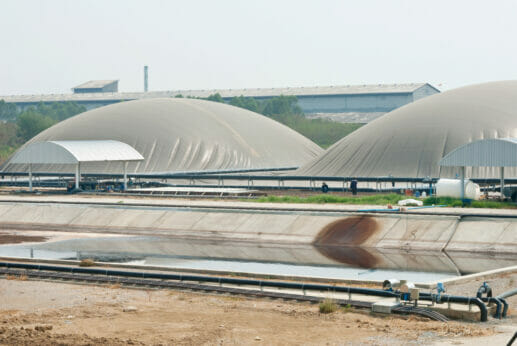
Bio-digesters can help dairies cut emissions, but they’re costly. Critics say they create the wrong incentives. (Photo: Shutterstock)
A recent County report shows that, in the last decade, bio-digesters helped Tulare’s dairies and feedlots reduce their emissions by nearly 20 percent. And because the entire system is sealed, dairy digesters went unscathed during the spring floods, Raudabaugh notes, preventing vast acres of effluent from escaping.
Harnessing methane also helps farmers build economic resilience. At the federal level, participants can earn clean fuel credits through the Renewable Fuel Standard program, while in California, biogas producers can also sell their carbon credits to oil and gas companies. All told, the added revenue could boost a dairy’s earnings by as much as 50 percent.
Critics, however, remain skeptical. With one digester costing anywhere from $400,000 to $5 million to install and operate, smaller operations often find them cost prohibitive. Yet for those that can afford them, it’s an enticing cash cow, says DeCoriolis, with a return on investment that scales up with increased methane production. “The value of the energy is great enough that it’s creating these perverse incentives to grow CAFOs.”
And it’s not just the manure, he adds—cows also burp 220 pounds of methane annually. “We’re subsidizing [the expansion of] these megadairy operations, all [in the name of] renewable energy,” says DeCoriolis. “And it isn’t going to do anything to reduce the other negative impacts.”
Size is relative, says Daniel Sumner, professor of agricultural and resource economics at the University of California, Davis. With the country’s average herd ranging around 300 heads, “just about all dairies in California are considered large by U.S. standards,” he writes in an email. But, he adds, the scale helps keep the Golden State’s dairy prices in check.
California’s small, pasture-based, organic dairies—many of which are clustered on the state’s North Coast—have a lighter environmental footprint, and they contribute just a sliver of the industry’s overall methane emissions. Yet that comes with high production costs that run 50 percent greater than Tulare County operations, says Sumner.
Although the premium operations fill a niche market, large-scale ones keep dairy accessible to Californians far beyond the grocery aisle, says Western United’s Raudabaugh. Consumer groups include food assistance services, including school nutrition and the Women, Infants, and Children (WIC) programs, as well as food banks, prisons and other public institutions. “There’s more cheese, yogurt and milk being consumed in these [services] than ever before,” she adds.
Dairy is also tightly woven into the fabric of California agriculture. Despite competing for land and water, the region’s orchards and milk farms have developed an unlikely partnership, says Sumner. Cows consume vast amounts of agricultural by-products, including almond hulls, citrus peel and other food-processing leftovers; the supplemental feed keeps crop waste out of landfill and “the dairy business afloat in the Valley,” he adds.
The field is further ingrained in the local and state economy. California produces nearly 42 billion pounds of milk annually, which, together with dairy products, total nearly 15 percent of California’s $51-billion annual agricultural production. And because the fresh fluid is costly to transport, dairy processing is highly regional, says Sumner. Statewide, the industry is responsible for almost 180,000 jobs, he notes, and supports another 132,000 indirect ones through trucking and hauling, veterinary services and other ancillary sectors.
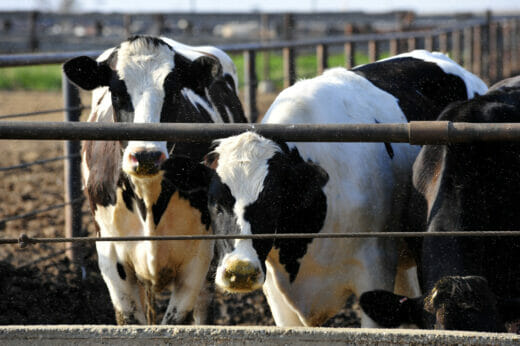
Nearly half a million milk cows live on 222 dairies in Tulare County. (Photo: Shutterstock)
But a resilient industry needs a strong foundation to keep it from getting too top-heavy. And that means fostering a diverse range in the scale of farms, says Jeanne Merrill, the former policy director for the California Climate and Agriculture Network. “Agriculture [prospers] when small and mid-scale family operations can not just survive but thrive economically.” In other words, policy measures aimed at sustainability need to also support economic viability.
Merrill points to CDFA’s suite of climate smart solutions that promote agronomic benefits through financial incentives. The multi-pronged approach fosters conservation management practices that improve soil health and sequester carbon, as well as irrigation measures that reduce on-farm water and energy use. The Alternative Manure Management Program also offers a more cost-effective and greener alternative to bio-digesters, minimizing methane at the source by up to 90 percent and simultaneously generating compost.
And dairy farmers are increasingly engaging in recharging over-pumped basins. The California Department of Water Resources LandFlex program incentivizes growers to fallow fields during drought or, as the case may be this year, flooding them in years with heavy rain to replenish regional aquifers.
These state incentive programs all help to keep family farms in business while advancing innovations. “It keeps the land [active] and on [a farmer’s] asset sheet,” says Raudabaugh, “so he can still pay his employees, bank notes and property taxes—all of which keep the local community going.”
The programs also help mitigate some of the risks of implementing innovation, adds Merrill. California farmers are a highly motivated group, she says. With program demand far exceeding available funding, “we’re seeing that they really want to engage in practices that’ll make a difference on their operations.”
Still, the looming challenges of climate change are daunting, Merrill concedes, and require much more ambitious action. “We have to bend that emissions curve in order to avoid some of the worst impacts, and in agriculture… these changes take time,” she says. “So, we have to invest now in order to reap the rewards later.”
ThThis story is part of State of Abundance, a five-part series about California agriculture and climate change. See the full series here.